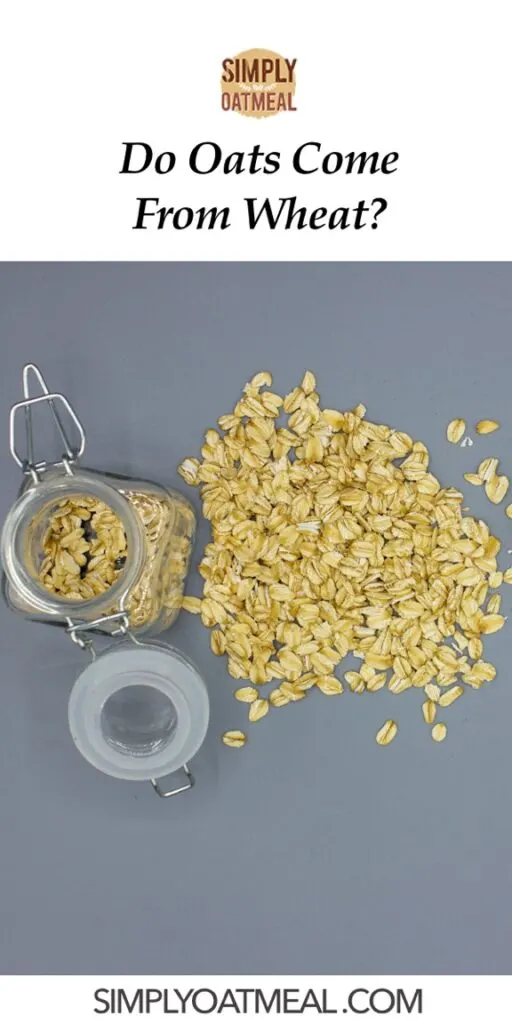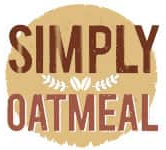If you have an inquisitive mind like I do, then you probably wonder where food comes from. Per se, the package of oatmeal that turned into a hearty and wholesome breakfast.
When considering worldwide consumption, oats are nearly as popular as rice. However, many of us are unfamiliar with how they are grown, what the look like, how they are processed and what part of the world they come from.
When it comes to concerns about celiac disease or gluten intolerance, the quest must be asked:
Do oats come from wheat? No, oats do not come from wheat. Oats come from the Avena sativa plant, which is a type of cereal grain that can be considered a distant relative within the grass family. Raw oats are gluten free, while wheat contains the protein gluten.
To further comfort your concerns, this article will explain what oats are, where they come from, and how they relate to or are different from wheat.
There are plenty of benefits of oats in your daily routine. Once you learn more about them, you will come to love them even more!
What are oats?
Oats are the kernel or seed of the Avena Sativa plant, a type of grass cultivated specifically for the cereal grain that it produces. Although the fields look very similar when grown, oats are different from wheat, barley and even rye.
When the plants is mature and it comes time to harvest the grains, the seeds are protected by a tough outer shell or husk. This exterior layer is an undigestible material known as oat fiber, which is removed during the initial processing of the grain.
Inside the exterior husk is the oat groat, the actual seed comprised of the oat bran, germ and endosperm.
Where do oats come from?
Whole grain oats, including the popular steel cut oats, rolled oats and quick oats, come from the oat groat and contain the bran, germ and endosperm.
There are different types of oats that are either cut, cooked, ground or flattened into flakes. The processing affects the final cook time and the potential usage for the oats.
What Do Oats Look Like?
The Avena sativa oat plantis a grass with tall stalks that grow in large fields similar to other cereal grains like wheat. As the grain matures, the seed develops in a feathery husk at the tip of the stalk, very similar to the growth of wheat.
When the grain is harvested, the papery husk remains intact to protect the kernel. Inside the indigestible shell lays an individual grain with a beige color and pointed tips at both end.
You can find oat groats in the store, however they are family uncommon. In general, the oats you see in the market have either been crushed, cut or rolled to achieve the desired features.
Crushed oats and steel cut oats retain their dense nature that takes much longer to cook. Scottish oats are a coarsely ground oat that requires more cooking time than instant cooking oats.
Rolled oats and quick oats are flattened in a similar manner, however the size of the flakes varies from large oval disks to fragmented bits that cook much quicker.
Types of Oats
With over a dozen different types of oats, there are so many options to choose from. Each kind is processed under different requirements to fulfill varying end results.
Ultimately, the differences contribute a range of cooking times that widens the possible uses.
Raw oats are safe to eat and are commonly served in preparations like overnight oats; whereby rolled oats, typically, are combined with liquid and left to soak for about 12 hours.
On the other hand, oat groats and steel cut oats are perfect for a heart breakfast that can be quickly made in an oatmeal cooker.
Steel cut oats are groats or kernels that have been cut in half with large steel blades. The resulting product is a highly desirable taste with a chewy texture that does require longer cooking time.
Rolled oats are groats that have been steamed and flattened by large rollers. The flakes take much less time to cook and retain a creamy consistency with a nutty aroma.
Quick oats are processed similar to rolled oats, however the pieces are fragmented into smaller bits that require even less cooking time.
Instant oats are fully cooked oats that are then ground into a fine powder. The grains can then be mixed with liquid to serve.
Oat flour is the raw oat germ, with the oat bran removed, ground into a fine powder. The flour is useful for making dough and batter for baked goods.
The diversity of oats and large range of oat products makes it easy to achieve a variety of recipes.
What’s the Difference Between Oats and Wheat?
Oats are a type of cereal grain in the grass family. Wheats are also a type of grass known as cereal grain, however they are a different species.
The most common strain of wheat is Triticum Aestivum, from the Triticum family, also known as common wheat. Nonetheless, there are many strains of wheat each responsible for producing a seed that is remarkably similar to oat grains.
Unlike wheat, oats are gluten free. Oats have a protein called avenin, which is a relative to wheat gluten, but has a different amino acid structure and is a minor protein in comparison.
Celiac disease, gluten intolerance or gluten sensitivity are serious concerns. Because all cereal grains require similar equipment to harvest, process and package, there is a risk of cross contamination.
To minimize the risk of gluten coming in contact with the oats, manufactures set aside facilities that do specifically process wheat free foods. If you have an allergy, it’s recommended to purchase certified gluten free oats and make sure to check the package to ensure that processing equipment is not shared with grains that do contain gluten.
Oats are naturally gluten free, but that doesn’t mean the manufacturing facilities have to be gluten free unless they specifically label the product as such. Our favorite brand of rolled oats, both regular and gluten free, is Bob’s Red Mill.
Is Oat Milk Gluten Free?
Raw oats are the primary ingredient to make oat milk, which, as previously discussed, are naturally gluten-free. Once again, this doesn’t assure that oat milk is always gluten-free.
Manufacturers include different types of oats, additives and flavorings, which may not meet the specifications to for gluten-intolerance.
First and foremost, are they using certified gluten-free oats. If they are not, then throw all bets out the window!
The manufacturing plant must be using machinery that is certified gluten-free for the product to truly be safe for anyone with serious celiac disease of gluten sensitivity.
Though there are many oat milk brands, our favorite certified gluten free oat milk is make by Oatsome. It’s perfectly balanced barista blend with a mild flavor that is a suitable milk alternative in coffee.
Benefits of Oats
The benefits of oats and oatmeal is wide ranging, no wonder it has become a coveted hot breakfast staple for so many households. Some call it oatmeal, while others may say porridge, but either way we’re generally talking about the same thing.
While oats have been commonly served as a healthy breakfast, they are quickly becoming a gluten free alternative to grains like wheat and barley.
If you are avoiding corn and rice, then oats may step into the limelight as an overlooked item that works well for lunch and dinner. Oats encourage weight loss as they are a fiber rich food that makes you feel full for extended amounts of time thereby curbing unnecessary overeating.
Oats have also been proven to reduce heart disease, cholesterol levels and blood sugar spikes after consumption.
Additionally, colloidal oatmeal is found in many skin, hair and face care products.
Ground oats, oat extract and oat milkare key ingredients in many body care formulas; as they have been proven to moisturize, nourish, cleanse, exfoliate and restore natural glow to your complexion.
Nutritional Content of Oats
Oats are a highly nutritious food item that contains plant based protein, dietary fiber, and healthy fat.
Protein and fat provide vital energy sources, while fiber help you feel full for longer. In the end, the feeling of fullness will curb hunger pains and help you reduce daily caloric intake.
In fact, the oatmeal diet is an eating regimen centered around eating oats to reach weight loss goals.
The soluble and insoluble fiber in oats provides balance for cholesterol levels, reduce blood pressure, and improve digestion.
Oats have a variety of essential vitamins and minerals that provide your body with nourishment for optimal health.
Both oats and wheat have similar nutritional contents, but oats have increased levels in almost every aspect, with the exception that wheat has slightly higher calories count.
The most significant factor is that oats have improved ratios of fiber, fat and protein.
Both grains are valuable sources of B-Vitamins, but oats contain slightly higher levels of ones that are difficult to find in food.
Wheat has more B2-riboflavin and B6-pyridoxine, but those are more readily available in foods, thereby easier to achieve the recommended daily intake levels.
Do Oats Contain Protein?
Yes, oats are a good source of plant-based protein, which adds to their popularity for vegans and vegetarians. In fact, oats provide almost 17 grams of protein in a 100-gram serving.
17 grams is roughly 35% of the Recommended Daily Intake (RDI) of protein for people following a daily regimen based on 2000 calories.
Oats have a higher protein content that most other grains, including wheat which has about 13 grams for the same 100-grams serving size.
The type of protein found in oats is very similar to the amino acids found in legumes. Though it is not considered to be a complete protein, it offers organic compound variability that is not found in any other grains.

Conclusion: Are Oats and Wheat the Same Thing?
Oats do not come from wheat. Even though they are both cereal grain grasses, they are not the same plant.
Oats are usually consumed as a whole grain, whereas wheat is most commonly ground into flour that is used to make a variety of products.
The most prevalent concern with consuming wheat is the presence of gluten. Wheat free products have dominated the marketplace since the worry over gluten has multiplied.
Oats are really gluten free, same for manufactured products like oatmeal and oat milk, but the items must be harvested, processed and packaged with certified gluten free machinery in specified facilities to be considered completely safe.
Do not confuse gluten sensitivity with oats side effects. Though the risk of allergies is minimal, there is always the concern that you should be aware of
Oats have slightly higher concentration of nutrition when compared to wheat. They have more protein, fat, and fiber, as well as more essential vitamins and minerals that help you achieve a healthy balanced diet.

Matt
Tuesday 13th of July 2021
Thanks for this info. It covered what I was curious to learn and some other previously unknown by me information.
Joshua
Tuesday 13th of July 2021
Thank you for the feedback, very much appreciated.